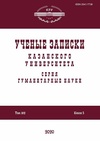Образ-схема как тип концепта (на примере концепта "круг" в русской языковой картине мира)
Image Schema as a Type of Concept (Using the Example of the Concept “Circle” in the Russian Linguistic Worldview)
Author(s): E. V. ReznikovaSubject(s): Semantics, Cognitive linguistics, Eastern Slavic Languages
Published by: Казанский (Приволжский) федеральный университет
Keywords: image schema; linguistic worldview; concept; cognitive variation; semantic variation; circle;
Summary/Abstract: This article discusses the traditional image schema theory, which is J. Lakoff and M. Johnson’s conceptual. Although it was introduced several decades ago, certain clarifications and refinements must be made to its framework and key terms in response to the latest advance in cognitive science. In particular, questions have been raised about certain properties of an image schema, such as bringing together different types of perception, relying primarily on human motor experience, abstractness, and being able to morph into other image schemas. For a better understanding of these properties, the concept “circle” in the Russian linguistic worldview was analyzed, and the following properties of the image schema were singled out by the methods of analysis (component, definitional, contextual, logical-linguistic, and etymological), modeling, and cognitive interpretation: spatiality (the presence of a spatial image), visualization, generalization of the experience to a logical scheme, high ability to form meaning due to the cognitive and semantic types of variation, and combinatorial activity (the ability to combine with various image schemas as parts of a larger image or to become the center of association for other image schemas in a different situation). Of special interest are the means of representation characteristic of an image schema: unlike in concepts of other types, its verbalization is performed with the help of not only lexical and phraseological means but also word-building morphemes with spatial semantics (prefixes). A macroimage schema can consist of many micro-image schemas bounded together under the principle of “family resemblance”, wherein any image schema can be central, i.e., play the role of a unifying one. The results obtained here on the refinement of the traditional image schema theory should promote further development of linguocognitive research.
Journal: Ученые записки Казанского университета. Серия Гуманитарные науки
- Issue Year: 164/2022
- Issue No: 5
- Page Range: 110-119
- Page Count: 10
- Language: Russian

